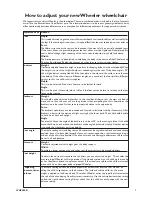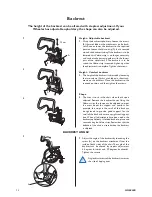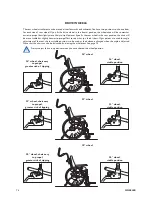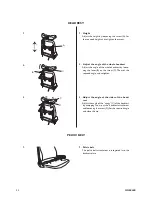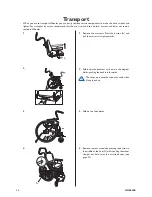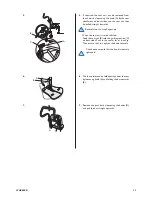
B
A
D
C
A
B
B
10
WHEELER
11
WHEELER
Height - individual adjustment
3.
Height is adjusted individually. Hold the foot plates,
loosen the screw (B) and set the required height
for each foot plate. Tighten the screws.
Height
1.
When you adjust the height of the foot plates, the
user is to sit in the chair with his or her thighs
resting relaxed on the pad. Loosen and remove
screw (A) whilst keeping the nut steady with a
spanner. Move the attachment to the required
height and tighten the screw.
5.
Footrests
The height, depth and angle of the footrests can be adjusted.
Depth
4.
The depth of the foot plates can be adjusted to one
of the three different positions. Remove the foot
plate by loosening the screw (B) and pulling the
foot plate straight outwards. Move the attachment
(C). The attachment must be pressed against the
footplate. Then fit the footplate into the new posi-
tion. Axle (D) should be fitted, so two millimeters
Then fit axle (D) in the new position and retighten
the screw.
Tip! Angle the seat backwards, so that the foot
plate is free of the lower frame tubes.
!
Angle
5.
The angle of the foot plate can be adjusted 10
degrees upwards and 10 degrees downwards.
Loosen the nut (A) and then alter the angle using
an Allen key. Tighten.
Height - extra high foot plate
2.
You can raise the foot plate additionally if the user
has very short legs. First follow the procedure
stated in point 1. Then loosened the screws (B)
and adjust the whole attachment upwards to the
required height. Tighten the screws. Note that this
adjustment means that the foot plates cannot be
folded upwards totally for transport.
If the foot glides away from the footplate, it
could be possible that the foot got jammed
between an obstacle and the wheelchair. Never
load the foot plate when it is loose
1.
2.
3.
This knob is only used
when the chair is to be col-
lapsed. See page 25. Never
move this knob when you
adjust the footrests.
4.
6 cm
3 cm









